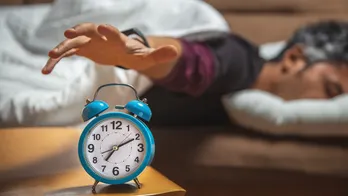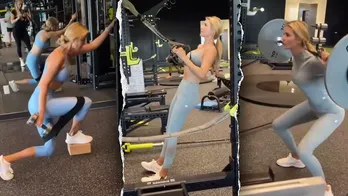This is the period talk you should've gotten
How did you learn about periods for the first time? Was it in a 5th grade classroom, split by sex? An embarrassing conversation with parents?
No matter what, it might've been confusing the first time around. When Kristyn Brandi, an OB/GYN and family planning doctor, learned about periods as a teen, she had tons of questions: "Why does it happen? What if it doesn't happen in the normal way? And what is the normal way?"
When menstrual health researcher Mandi Tembo learned about periods, she said they felt "like a secret."
Periods affect our lives in countless, connected ways, especially as we get older. But most of us haven't learned about them since we were kids — if we learned at all. Learning to manage your period can help you take control of your health, emotional well-being, social life and even your finances.
At Life Kit, we thought it was high time for a refresher. So we asked two period experts: How would they give the period talk? Here are six of their biggest pieces of advice.
1. Understand the science behind your period
If you want to get acquainted with your body and how your period affects it, you need to know the science first. While the average menstrual cycle lasts 28 days, no two cycles are the same — so, start by figuring out what your individual timing is and what your hormone fluctuations look like.
To start, your cycle will consist of four steps:
- The menstrual step: This is when you're "on your period." The cycle begins with the first day you start bleeding. That blood is a shedding of your uterine lining — more on that later — through your cervix, and out your vagina. It happens because your body is preparing for the possibility of pregnancy. Tembo says that at this point in the cycle, you might feel really low energy. That's because "your body's doing work ... and shedding a lot of blood. You're less social. You just wanna rest." So if your body is telling you it needs rest, listen!
- The follicular step: You enter this stage after you've shed your previous uterine lining, around day six of your cycle. It's named for the ovarian follicles, little sacs in your ovaries that contain all of your immature eggs from the time you're born. At this point in the cycle, your body releases follicle-stimulating hormone (FSH) to prompt some follicles to grow and mature the eggs inside them. One egg will fully mature – inside something called the dominant follicle – so that it can be released by the time you ovulate. The growing follicles also tell your ovaries to start making estrogen. The estrogen encourages your uterus to produce cells, which begins the process of building a new thick uterine lining. After the follicular step, that dominant follicle will release its egg and later morph into something called the corpus luteum. Any other follicles that were activated this cycle will shrink and eventually disappear permanently, along with the eggs inside of them.
- The ovulation step: Estrogen peaks in the days leading up to ovulation, around the halfway point of your cycle. That signals the brain to send out a new chemical called luteinizing hormone (LH). When LH spikes, your body knows that it's time for your dominant follicle to release its egg. This is also when you have the greatest chance of getting pregnant – or when you're most fertile. This period of high fertility is about six days. You're most likely to get pregnant a few days before and after your body releases its egg, Brandi says.
- The luteal step: This is about the last 14 days of your cycle, and it's named for the corpus luteum we mentioned earlier – a group of cells that forms in the ovaries after the egg has left. The corpus luteum is created from the materials that made up your dominant follicle, and it takes the place of where that follicle once was. It then helps the uterus become a healthy place for a fetus to grow by producing estrogen and progesterone. Progesterone is the main hormone your body needs to stay pregnant and continue to build up your uterine lining. It also helps supply your uterus with oxygen and blood.
If a fertilized egg implants itself in your uterine lining, your body will hang onto its lining rather than shedding it. In that case, you might notice a missed period – a common sign of pregnancy. If you're not pregnant, all of these hormones (progesterone, estrogen, LH and FSH) will start to plummet. This is also when you might start to feel some symptoms of premenstrual syndrome (PMS) because your body is reacting to these changing hormone levels. But the good news is PMS symptoms will usually dissipate once your cycle starts back up.
2. Track your cycle!
Now that you know roughly where the different phases of your cycle might fall, you can start to track and plan your life around them. There are tons of apps out there to help you log your cycle and symptoms. If you have privacy concerns, some apps — like drip. — promise not to share your data with 3rd parties.
You can also do it the analog way – with a pen and paper. Start by marking the day your period begins, then however many days your menstrual step lasts (until your bleeding stops). Once you accumulate a record of past periods, you can estimate the length of your average cycle and predict when it's going to start again.
It's helpful to keep track of any other symptoms you're having. Start by asking how your period affects your everyday life — maybe you notice you have heavier bleeding halfway through your menstrual cycle and need to carry around extra supplies. Or maybe you're spotting near the end of it and can go without.
Other factors and changes you might want to note: How is your mood? What about pain levels? Are you trying a new form of contraception, and is it affecting your bleeding? Are you having sex on certain days? What does your discharge look like? (Note: If it's clear, milky white or off-white and has a slight odor, don't worry. If it's dark yellow, brown, green or gray – or if it has a strong odor – that may indicate an infection and you should talk with your doctor.)
Tracking also helps point out when something's wrong, like if your period stops suddenly. That can happen for reasons other than pregnancy – such as high stress levels or exercising a lot.
3. Mild pain is expected. Severe, persistent pain is not.
Pain is one of the most common period symptoms out there: More than half of people who menstruate have pain at some point during their cycle. Usually, that pain is mild.
But what does mild mean? Brandi says it's pain that can be remedied with over-the-counter medicine or other supportive measures, like putting a hot pad on your stomach.
But if the pain is persistent, or stops you from going about your day, see a doctor. It could be a sign of a common menstrual disorder.
"There are a myriad of reasons why you could be experiencing pain," says Tembo. "My encouragement would be: If you feel like something's wrong or different, just get it checked out."
When you talk with your doctor, make sure you have on hand any information about your cycle that you've collected. Remember: You know your body better than anyone else.
It's also a good idea to think of questions you want to ask ahead of time; doctor appointments can go by pretty fast.
4. Decide if you even want a period
It's true: You may not even need a period.
"If you're not trying to get pregnant and you don't like having a period, it's not something that's necessary for your health or wellbeing," Brandi says.
In fact, you can choose to stop your period completely with medication. For example, if you take hormonal birth control pills, Brandi says you can skip your placebo pills so you're always at the same level of hormones.
There are a number of reasons why stopping your period could be a smart decision for you and your body. Maybe you have painful symptoms that are difficult to manage. Or if you're nonbinary or a trans man, getting a period could contribute to gender dysphoria.
"It may be really important for someone to use medications to stop having a period so they feel more like what their natural body should be," says Brandi.
If you're interested in stopping your period, speak with your doctor about different birth control methods.
5. Find what products – if any – work for you
There are lots of different menstrual products out there. Choose whatever works best for your body and lifestyle, experts say.
First, there are disposable options like pads and tampons. One or the other might work better for you depending on your comfort levels: Tampons might not feel as comfortable as using a pad, and for some people, the opposite might be true. It all comes down to trial and error – so experiment!
There are also reusable options like menstrual cups, reusable pads, period underwear, menstrual sponges or menstrual discs. If you don't have access to disposal bins or a private space to change out your products, then reusable might be a good option. Plus, they're a one-time investment.
Another option is to use no product at all – a practice called free bleeding. Some people free bleed because other options aren't available to them. Some do it intentionally as a way to destigmatize period blood. And others do it because it feels comfortable and easy for them.
"There's no one right answer," Brandi says. "You can use a combination of products, or try them all out and see which one works best for you."
6. Talk about it with friends and family
If you want to help eradicate period stigma – start by opening up a dialogue about your period with the people in your life.
"It's about engaging in conversations around menstrual health with your friends, with your partners, with your peers, with your children, with your parents," says Tembo.
"And that's making sure that you understand that bleeding is not taboo, that you can still be sexy when you're on your period, that bleeding looks different for different people, that not all menstruators are the same."
Talking about your period helps others learn about theirs. And the more we all learn about our individual cycles, the better we can understand our individual needs.
After all, your period is completely unique to you – and that's pretty cool.
The audio portion of this episode was produced by Margaret Cirino and edited by Rebecca Ramirez and Meghan Keane. The digital story was edited by Danielle Nett. Our visuals editor is Beck Harlan. We'd love to hear from you. Leave us a voicemail at 202-216-9823, or email us at LifeKit@npr.org.
Listen to Life Kit on Apple Podcasts and Spotify, or sign up for our newsletter.
Disclaimer: The copyright of this article belongs to the original author. Reposting this article is solely for the purpose of information dissemination and does not constitute any investment advice. If there is any infringement, please contact us immediately. We will make corrections or deletions as necessary. Thank you.







